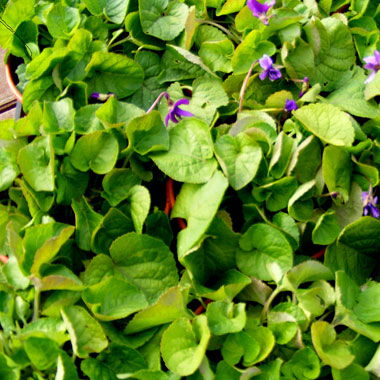


Sweet Violet
Viola odorata

Violets are perennial herbs which bloom from March until early June,
preferring a moist shaded situation but in truth are very tolerant of most positions.
The flowers are generally deep purple in colour, but maybe blue, pinkish or even white.
All parts of the plant can be used.
The flowers should be gathered whilst in full bloom, the leaves at any time and the roots in the autumn.
The flowers are most commonly used in salads, jellies, for flavouring sugar and candied for decoration.
One of the best uses is to combine their flavour and perfume with chocolate.
A tea made from the leaves and flowers can be used to treat digestive problems,
and recent research has shown the presence of a derivative of salicylic acid (naturally occurring aspirin)
which substantiates its use during historical times for headache, pains and as a sedative.
The fresh leaves can be applied to the skin as a poultice to relieve swelling and irritation.
The fragrant essential oil is used in perfumery,
although in 1893 the aromatic element of the violet perfume, known as ionone,
was first synthesised and is used in less expensive perfumery.
If added to a warm bath, the freshly crushed flowers are soothing to the skin and the aroma is very relaxing.
The essential oil is very useful against skin problems.
A garland of flowers worn around the head is thought to ward off headaches.
The Latin Viola is the latin form of the Greek Ione.
Legend has it that Jupiter changed his beloved Io into a white heifer for fear of Juno's jealousy.
He then caused these small flowers to grow from the earth as food for her and gave them her name.
The ancient Greeks thought of the violet as a symbol of fertility and they were used in love potions.
Chocolate and Violet Sorbet
- 30 sweet violet flowers
- 175 g caster sugar
- 50 g cocoa powder
- 125 g high quality dark chocolate
Warm 500 ml of water in a saucepan with the caster sugar, stirring until the sugar is dissolved,
do not allow the syrup to get too hot.
Add the washed violet flowers to the warm syrup and leave to infuse for up to 1 hour.
Remove the violets with a slotted spoon, and rewarm the syrup in the pan.
Add a little syrup to the cocoa in a small bowl and blend well before returning the cocoa mixture to the pan.
Break the chocolate into small pieces and add to the pan, whisking well to dissolve the chocolate.
Bring the mixture to the boil, then immediately remove the pan from the heat
and place in a pan of iced water for at least 15 minutes.
When the mixture is completely cold pour into an ice-cream maker and churn until set,
then transfer to a plastic container and freeze overnight before serving garnished with violet flowers.
This sorbet is lovely at the end of a rich meal
and can be served with a raspberry sauce easily made by processing raspberries
with a squeeze of lemon juice in the food processor
and then straining the sauce through a sieve to remove the seeds before serving with the sorbet.